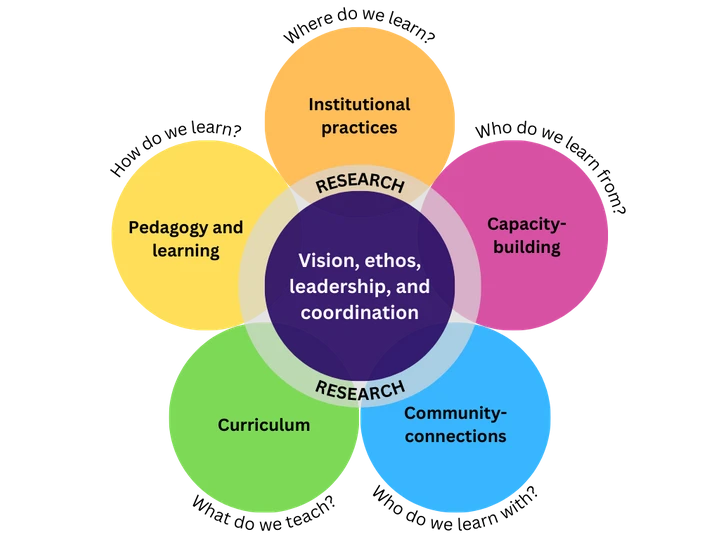L'école ...
De ceux qui sont curieux, et ont envie d'apprendre
Note
- Define the project (extract from jb-astro)
- Extraire classer et implémenter OU Open Course
Introduction
Transforming Education
Our Education system still rely on a theoretical basis from the 19th century …
An organizational perspective
An organization that embodies education for sustainability must take on a whole-institution approach, looking into various dimensions of the institution such as pedagogy and learning, curriculum, community-connections, capacity-building, institutional practices, and vision, ethos, leadership and coordination (Mathie & Wals, 2022 - PDF). What does such a transformation look like in each dimension and what does it entail?
Why do we learn? What is the purpose behind our teaching?
- Includes learner voice and participation
At the core of any transformation is the vision of what one is transforming to. In the context of ESD, what is it we aspire our organization to achieve and become? What are the guiding values and principles that would engender authentic sustainability transformation? Who participates in vision-building and how are they involved? How does your organization coordinate amongst the various stakeholders with diverse needs and priorities?
What do we learn?
Due to the complexity and interrelated nature of sustainability issues, an ESD curriculum is a glocal one – situated in the local context but broadened by a global view. It also seeks to include knowledge and practices often pushed to the periphery. Topics are cross-cutting, integrating ideas from diverse disciplines to enable a richer view, and work among learners is multidisciplinary. What does your curriculum grounded on sustainability look like? What new voices and knowledge does it include?
How do we learn?
In this time of rapid and unpredictable change, current pedagogies must inspire curiosity and sustain the motivation of the youth, while helping them navigate the constantly shifting landscape. Sustainability-oriented transformative pedagogies could involve place-based learning, critical reflection and dialogue, experiential learning, and challenge-based learning – to name but a few. How is that organized in your organization?
Where do we learn?
Organizations rooted in sustainability should grow into a living embodiment of ecological consciousness and care, health and well-being, inclusivity, and democratic participation. This can happen in many ways and in various areas of the organization, e.g. in the building, in the cafeteria and in the classrooms, in the library. Think about renewable energy, recycling, a healthy and sustainable canteen, a repair shop, classrooms and plazas with lots of greenery, the conscious use of technology, and the accessibility of spaces, the inclusion of subaltern groups, zero tolerance of discrimination and racism. What makes yours an organization that breathes sustainability? How important are sustainable thinking and action to the users within your organization?
Who do we learn from?
In higher education, it isn’t just the students who need to learn – the teachers, staff, policy-makers, cleaners, and workers must take part in the transformative learning process as well. How can we engage members of the organization’s community to renew knowledge and comprehension of wicked problems and change their practice to address them in a sustainable way? What kind of opportunities or spaces are provided to allow staff to discuss, learn and ask about, listen to, and reflect on sustainability-related issues?
Who do we learn with?
While it takes a village to raise a child, it takes the whole community to tackle a wicked problem. Organizations are deeply embedded in their social and cultural context, and any transformation must extend beyond the four walls of any organization and into the wider community. The whole community becomes a living laboratory for authentic learning and meaningful engagement. What do we have to offer our partners in the immediate community and vice versa? What does our network look like and how do we expand it toward those who want to learn with us? How do we ensure equitable collaborations? How far do our partnerships go?
What I think about institutional transformation
It will never happen. The inertia is too big for such massively burocratic body to change (I have experienced it myself). Also, I don’t think the SDGs are at the core of school practices. I think schools are a place where pupils are
This Website
An Experiment
I believe much more can be done to transform education, at an individual scale
